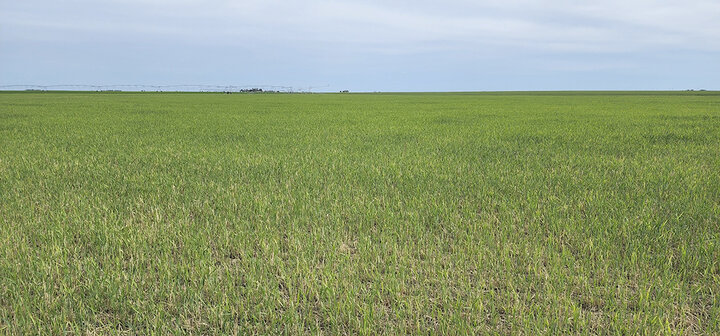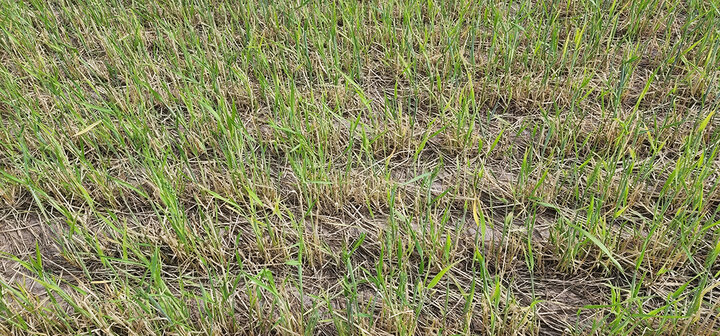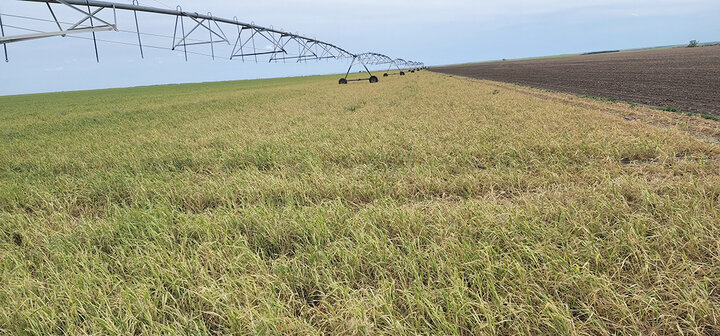This week’s wheat disease surveys were combined with wheat field days in Perkins County (Figure 1) and Cheyenne, Box Butte and Banner counties. On June 20, leaf rust (Figure 2) was observed at trace to low levels in research plots at Havelock Farm in Lincoln, Lancaster County, in southeast Nebraska. Due to its late arrival, the impact of leaf rust on yield will be minimal. Fusarium head blight (Figure 3) was also present in the plots at low to moderate levels.
Due to dryer than normal conditions, fungal diseases did not develop to damaging levels this year in the majority of wheat fields.



The major factors that have impacted the wheat crop in 2022 are drought-like conditions — especially in western Nebraska — freeze damage, hail, and the virus diseases wheat streak mosaic and barley yellow dwarf. Freeze occurred earlier in the growing season and caused significant injury to the wheat crop, especially in western Nebraska.
During this week’s surveys, symptoms of freeze damage were conspicuous in growers’ fields and research plots (Figure 4). Hailstorms have also occurred in recent weeks throughout the wheat growing regions in the state and have caused varying levels of damage, including total loss in some fields (Figures 5 and 6). Wheat streak mosaic is prevalent in the Nebraska Panhandle. Varying levels of incidence and severity of the disease have been observed (Figures 7 and 8), from mild to entire fields affected. Barley yellow dwarf has also been observed at varying levels throughout the wheat growing regions in the state.




Management to Minimize the Impact of Wheat Streak Mosaic on Next Year’s Wheat Crop
- Due to the pre-harvest hailstorms that have recently occurred and can possibly recur, it is recommended that vigilance be exercised in controlling volunteer wheat, especially that which emerges from grain shattered to the ground by pre-harvest hail. If uncontrolled, the volunteer can act as a green bridge for wheat curl mites, the vectors of the wheat streak mosaic complex of viruses, as well as the viruses, between harvest and planting of wheat in the fall. The mites will then move from the volunteer, infest the newly emerged winter wheat crop and transmit the viruses. Post-harvest volunteer in wheat fields, volunteer in summer crops such as sunflower, and grassy weeds should also be controlled. Volunteer should be completely dead at least two weeks before planting in the fall.
- Do not plant wheat too early in the fall. Early planting allows a longer time during which environmental conditions are favorable for virus vectors (wheat curl mites) to infest the newly emerged wheat crop and transmit viruses to it. It also allows a longer time for the viruses to replicate within the wheat crop and cause damage before dormancy.
- A few varieties have good resistance to the wheat streak mosaic virus complex and the wheat curl mites that transmit the viruses. Plant resistant or tolerant varieties if available and adapted to your area. See the Nebraska Fall Seed Guide and the K-State Wheat Variety Disease and Insect Ratings.
- Several crops in the grass family (wheat, corn, rye, oats, barley, sorghum, foxtail millet, proso millet, pearl millet) and grassy weeds (jointed goatgrass, downy brome, Japanese brome, cheat grass, sandbur, crabgrass, banyardgrass, Canada wildrye, stinkgrass, witchgrass, green foxtail, yellow foxtail) are hosts to wheat curl mites or wheat streak mosaic, or both. Avoid planting wheat next to grassy weeds or late maturing mite-virus host crops.

